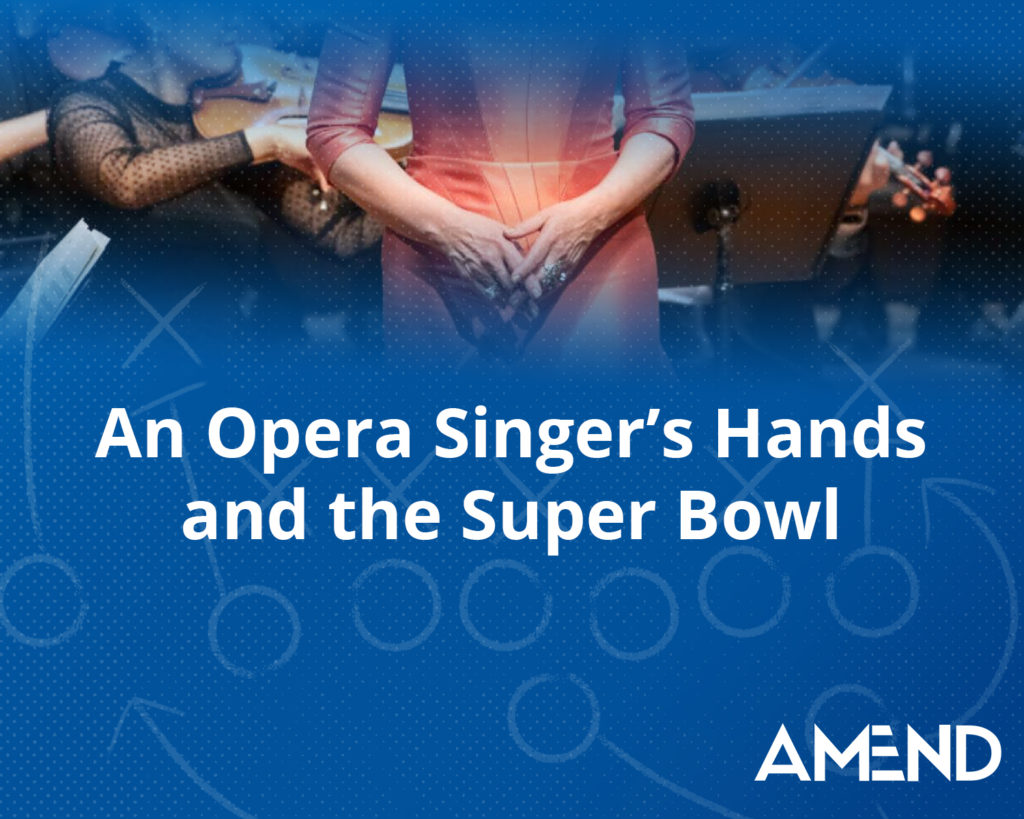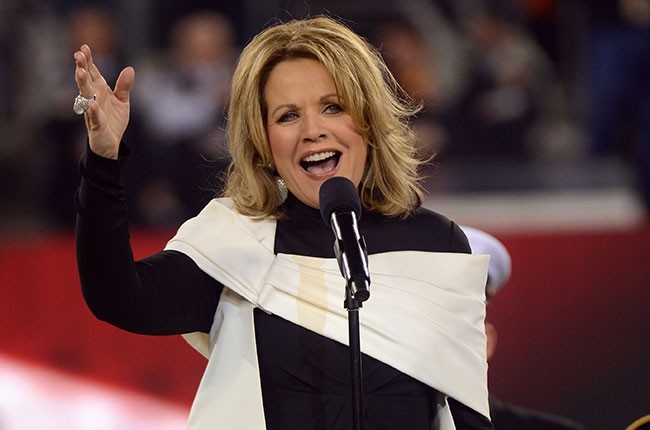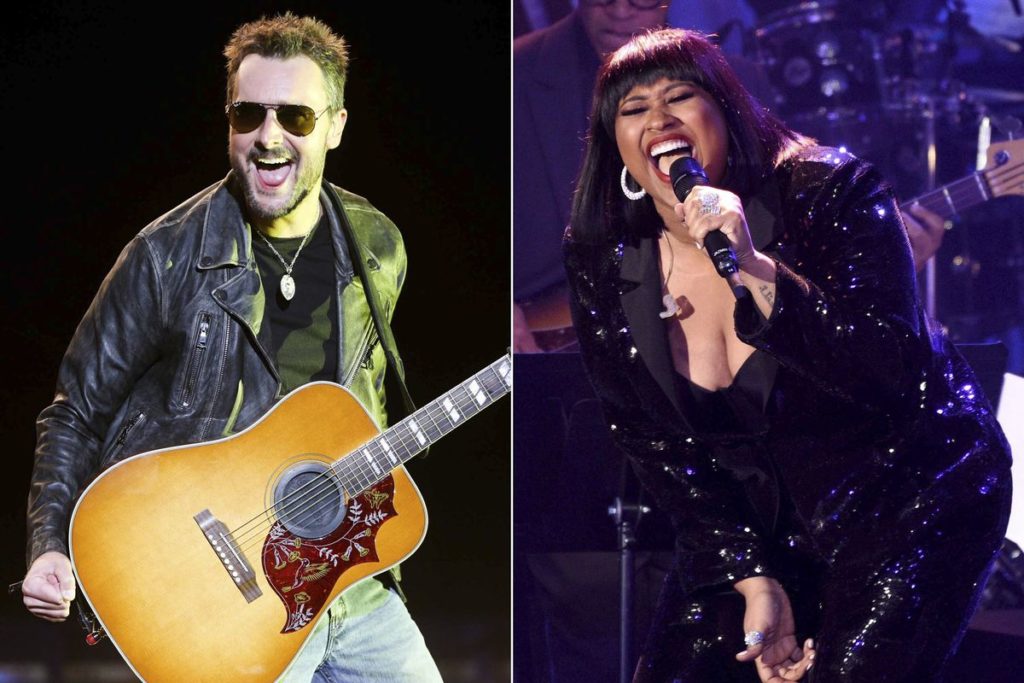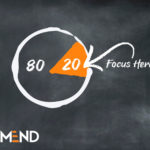
Paul Bessire, AMEND’s VP of Data Science, explains why he thinks of Renee Fleming’s hands when he thinks of the Super Bowl
I spent more than a decade and a half running simulation engines to predict the outcomes of hundreds of thousands of sporting events. Thinking back on that time, most of the games and predictions blend together. There were some bad beats, some amazingly fortunate outcomes and, fortunately, more wins than losses (despite plenty of each), but ultimately, I became numb to the outcomes.
This time of year, though, has always been different. The Super Bowl. Sure, the game is compelling, and I do think I can recite every prediction those models had for the Super Bowl and its outcome on the field since Super Bowl XL. Yet the first thing that pops in my head when I think Super Bowl and predictions is Renee Fleming’s hands.
It’s a name that is relevant to many, but likely forgotten by most. Opera star Renee Fleming sang the National Anthem in 2014 before the outdoor Super Bowl in New York. As part of my predictive analysis, I reviewed ALL prop bets available. This included researching outcome likelihoods that extend far beyond the game. The best value I ever found in any wager ever was that Renee Fleming would NOT wear gloves to sing at +350, which means that anyone wagering $100 would win an additional $350 if she walked on to the field without gloves (more on props below). “Yes” she would wear gloves was the favorite, requiring more than $250 wagered just to win $100.
I get the logic of the book. Opera singers are known for wearing gloves. The Super Bowl is in New York. Outside. In February. The combination of operatic homage and need for warmth would have to mean gloves. Right?

Wrong. Not for Renee Fleming. Google her. I looked at thousands of photographs of Renee Fleming. No gloves. Never. Plenty of capes. No gloves. It’s almost as if she made a fashion statement by NOT wearing gloves. (Also, it was 49 degrees, so the cold thing was not a big deal either.)
Ten minutes before the Broncos and Seahawks kicked off, Renee Fleming walked onto the field with bare hands. I immediately high fived everyone in the room and the prediction machine was already way up.
Want AMEND to dig this deep to unlock value in your organization? Reach out to learn more here.
Super Bowl LV
There may not be that kind of obvious answer this season. But, seven years later and despite applying data science to a much broader range of problems and industries, I still cannot get away from digging deep on Super Bowl LV props.
For entertainment purposes, here are two of the most interesting prop bet values for Super Bowl LV with thorough analysis. Read more about prop wagers as well as a list of more sides that look valuable below. We will focus on everything except the game. As I alluded to earlier, I have come to enjoy the ability to be a sports fan again.
All lines courtesy of my friends and many former colleagues at Oddsshark.
1. The National Anthem – UNDER 1:59
Yes, I have an algorithm that predicts length of the National Anthem at the Super Bowl. Obviously.
I’ve been updating and tweaking it since Aretha Franklin and Aaron Neville sang it together in Detroit in 2006 in 2:09 (wager is first “Oh” to first “Brave”). Interestingly, that was the last time we had a duet before Jazmine Sullivan and Eric Church were tapped for this year, which feels relevant. Aaron Neville sang the National Anthem for the Super Bowl in New Orleans in 1990 and went 1:29. His other public performances of the anthem are right in that range, averaging 1:26. Aretha Franklin’s many public performances of the National Anthem average just over THREE minutes (literally double Neville’s average). They met somewhere in the middle.
The average Super Bowl performance lasts 110 seconds. The average non-Super Bowl National Anthem performance by those same artists (I have a database) lasts 98 seconds, which means anthem singers usually add about 12% for the Super Bowl. Side note: the average non-Super Bowl performer singing the National Anthem publicly is about 1:29, so Super Bowl artists already tend to go long.
Jazmine Sullivan sang the National Anthem for NHL All-Star Game in 2016. It lasted exactly 1:38. Eric Church. Well. He has never sung the National Anthem publicly. It seems to be something he’s strongly resisted. What do we do? In absence of data, improvise. Never underestimate the role of creativity in math.

I usually start comparing the performances of songs like Amazing Grace or Ave Maria that many singers have public records of singing. That works to some extent in this situation as there are several videos of Sullivan singing songs that Aretha Franklin or Whitney Houston (who went 1:55 in this performance) have also performed. There is very little of that for Eric Church. Luke Bryan, who went 2:04 (holding the last note a little long to sync up with a flyover) is the only other male vocalist to sing the National Anthem at the Super Bowl in the last 14 years. Only 12 solo male artists have done it in the previous 54 years.
But there may be a simpler answer. This. Sullivan did a rendition of the song before a 76ers game aided by a guitar that lasted 1:44 and even included some of her signature riffs. Since Church and Sullivan had not even met as of last week and Church admits to not being capable of the range it takes to sing the song, this may be exactly what we see. Any guitar played before “Oh” or any riffs after the first “brave,” do not impact the time.
Adding 12% to 1:44 is 1:56. Barely under.
2. The Weeknd’s First Song at Halftime – Blinding Lights (+400) OR In Your Eyes (+450)

“Blinding Lights” is currently the second betting favorite behind “Starboy” to be The Weeknd’s first song performed at halftime, while “In Your Eyes” is the fourth favorite.
“Blinding Lights” is also the clear favorite (-240) to be his last. While it could be the last, I don’t think it will be both and there is far more value in it being the first (risking $100 nets $400 for first as opposed to $240 needed to win $100 with last). Said differently, one only needs 20% confidence to justify “Blinding Lights” as the first, while a wager on it being last requires 71% confidence.
My approach to these types of props is to review set lists from recent concerts to look for patterns. The pandemic is not helping that. Artists are rarely performing full shows. Both songs noted here as values have been commonly performed by The Weeknd publicly over the last year.
We are left with some psychology and media to consider as we look for value.
Your parents watch the Super Bowl. The Weeknd may sound like an 80s pop star, but he’s a 30-year-old Canadian singer who rose to popularity less than ten years ago and enjoys trying to look… unique. He’s not “playing the classics” like when Bruce Springsteen, The Who or Madonna performed in recent years.
Establishing familiarity and dodging controversy is generally important at the beginning of a performance to this broad of an audience. Hamish Hamilton has directed the Super Bowl halftime show each year since 2010. The performances generally start with something dramatic and familiar, then hit the audience with energy for a few songs, sneak in a new song (for newer artists), follow that up with a very slow moment and end with energy.
The Weeknd’s look may be dramatic enough, but the two songs (from the list of wagering options) that would seem to make for a strong, powerful, dramatic opening are “Blinding Lights” and “In Your Eyes” (+450).
“Blinding Lights” was 2020’s most streamed song and appears (along with The Weeknd himself) in the commercial played during previous football broadcasts to promote this appearance. It immediately establishes recognition for the broadest audience.
“In Your Eyes” builds with crescendo, but likely works as an opener with Kenny G. Beginning the performance with the camera focused on a 64-year-old saxophonist and one of the top selling artists of the 1980s and 90s is another way to connect with the broad audience.
Given the odds for “In Your Eyes” and “Blinding Lights,” one could play both and still be up if either is the first song.
Per this analysis, I think the two most likely full set lists are:
Option #1
- Blinding Lights
- Can’t Feel My Face
- The Hills
- Save Your Tears
- Off the Table
- Scared to Live
- Starboy (+1400 to be last song)
Option #2
- In Your Eyes (with Kenny G)
- Starboy
- Can’t Feel My Face
- Save Your Tears
- Off the Table
- Scared to Live
- Blinding Lights
“Scared to Live” would be an awesome first song, but it’s not on the list for the prop.
There is also an option for Over/Under total number of songs performed at halftime show with a line of 8. This would suggest UNDER.
Other Props with Value
Coin Toss (NO)
Tom Brady is shown before Patrick Mahomes during the National Anthem (-130)
A scoring drive will take less time than the National Anthem (-350)
Doja Cat will NOT perform (-650)
Drake will NOT perform (-700)
Ariana Grande will perform (+315)
Kenny G will perform (+325 – see above)
Roger Goodell will be shown during the game one or fewer times (-120)
Joe Biden’s name will NOT be mentioned multiple times during the game (-290)
Tom Brady’s tenth Super Bowl appearance will be noted before his age (-150)
Orange Gatorade will be poured on the winning coach (+150)
The MVP will mention his coach first in his speech (+1000)
Props
Oddsshark has some great information on what props are here.
The most common question I get is some variation of, “well then why doesn’t Jazmine Sullivan go bet her life’s savings on the OVER of the National Anthem and hold the last note until it hits?” In other words, essentially everything above is known in advance with some level of certainty. Props are heavily limited and heavily monitored – and every sportsbook offering them (many do not or cannot offer these wagering options) has final say on whether it accepts a wager and how it pays them out. Typically, bettors cannot wager more than $50 or $100 on any of these options and books can turn them off or change the lines at any time for any reason.
Typical game wagers (sides and totals) use -110 odds for either option (either team or the over or under), which means that the sportsbook has set a line it believes will get equal action. The -110 means that it takes $110 to win $100. Sportsbooks make money from losing wagers.
With prop wagering, the odds matter just as much as the options because all options are not created equal. When the odds are ‘+’ or “plus money,” this means that one receives more back than he or she wagers if correct (plus the original wager). If the odds are ‘-‘ or “minus,” one must risk more than he or she will receive as winnings.
The confidence needed to justify value is equal to or greater than the breakeven point over time. For plus money options, this can be calculated as 100/(100 + Odds). For instance, for the MVP mentioning coach first at +1000, one only needs 9.1% confidence (100/1100) to justify. Minus odds are the opposite. Breakeven is calculated as Odds/(Odds + 100) where Odds here is the absolute value of the number. For Tom Brady being shown first at -130, one needs 56.5% to justify (130/230). This is also why most sports wagerers need to be at least 52.4% accurate to profit as most lines are -110.

Paul Bessire is VP of Data Science (and resident nerd) at AMEND Consulting. He has used data and technology to become one of the world’s foremost authorities at predicting sports and is now focused on doing the same with other industries. Previous to AMEND, he worked for Western & Southern and FoxSports and founded and exited his own company, Prediction Machine, which simulated real-time outcomes of over 100,000 events a year across over 100 leagues in seven different sports.
Our team develops solutions to fit your performance-driving KPIs and support your short and long-term strategy planning. Fill out the form below if you’re interested in partnering with AMEND to dig deep into your data to unlock value in your organization.









